
Ulva lactuca, also known by the common name sea lettuce, is an edible green alga in the family Ulvaceae. It is the type species of the genus Ulva. A synonym is U. fenestrata, referring to its "windowed" or "holed" appearance, Despite the name, it is not a lettuce

Poke is a dish of diced raw fish tossed in sauce and served either as an appetizer or a main course.
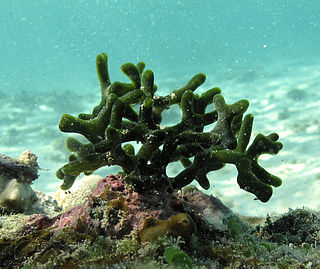
Codium is a genus of edible green macroalgae under the order Bryopsidales. The genus name is derived from a Greek word that pertains to the soft texture of its thallus. One of the foremost experts on Codium taxonomy was Paul Claude Silva at the University of California, Berkeley. P.C. Silva was able to describe 36 species for the genus and in honor of his work on Codium, the species C. silvae was named after the late professor.

Turbinaria ornata is a tropical brown algae of the order Fucales native to coral reef ecosystems of the South Pacific. Turbinaria ornata is more commonly referred to as crowded sea bells in the US and crowned sea bells worldwide. It can quickly colonize these ecosystems due in part to its method of dispersing by detaching older and more buoyant fronds that travel on surface currents, sometimes in large rafts of many individual thalli, or fronds. Some scientists are investigating whether the increase in density of seaweeds, and a decrease in living coral density, on coral reef ecosystems indicates a change in the health of the reef, focusing studies on this particular species of brown alga.
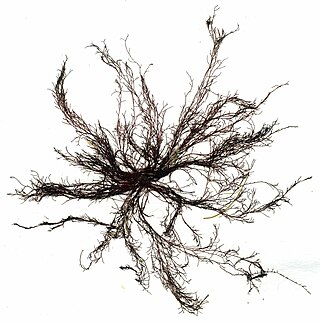
Polysiphonia is a genus of filamentous red algae with about 19 species on the coasts of the British Isles and about 200 species worldwide, including Crete in Greece, Antarctica and Greenland. Its members are known by a number of common names. It is in the order Ceramiales and family Rhodomelaceae.
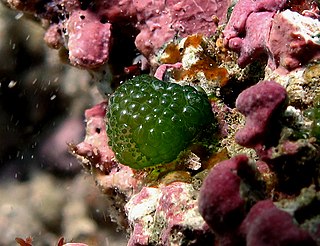
Dictyosphaeria is a genus of green algae in the family Siphonocladaceae.

Valonia is a genus of green algae in the Valoniaceae family. The genus Ventricaria is now regarded as a synonym of Valonia.

Limu, otherwise known as rimu, remu or ʻimu is a general Polynesian term for edible plants living underwater, such as seaweed, or plants living near water, like algae. In Hawaii, there are approximately one hundred names for kinds of limu, sixty of which can be matched with scientific names. Hundreds of species of marine algae were once found in Hawaii. Many limu are edible, and used in the cuisine throughout most of Polynesia.

Isabella Aiona Abbott was an educator, phycologist, and ethnobotanist from Hawaii. The first native Hawaiian woman to receive a PhD in science, she became a leading expert on Pacific marine algae.

Asparagopsis taxiformis, formerly A. sanfordiana, is a species of red algae, with cosmopolitan distribution in tropical to warm temperate waters. Researchers have demonstrated that feeding ruminants a diet containing 0.2% A. taxiformis seaweed reduced their methane emissions by nearly 99 percent.

Hydroclathrus is a genus of perforate brown alga, of the phylum Ochrophyta and the class Phaeophyceae.

Colpomenia sinuosa, commonly named the oyster thief or sinuous ballweed, is a brown algae species in the genus Colpomenia. It is the type species of its genus and is widespread in tropical to temperate zones around the world.

Gracilaria parvispora, also known by the common names long ogo, red ogo, or simply ogo, is a large species of marine red alga in the genus Gracilaria, endemic to Hawaii. It is highly sought after as an edible seaweed and is popular in mariculture and the marine aquarium trade. Also known as limu ogo in Hawaiian.
Dictyota sandvicensis is a species of brown seaweed in the family Dictyotaceae.
Formerly known as Sargassum echinocarpum, Sargassum aquifolium is an abundant brown algae of the order Fucales, class Phaeophyceae, genus Sargassum. In Hawaii, it is commonly known as limu kala. This alga is endemic to Hawaiʻi, one out of the four endemic species of Sargassum.

Sargassum polyphyllum is a species of brown macroalgae or limu (seaweed) in the order Fucales.
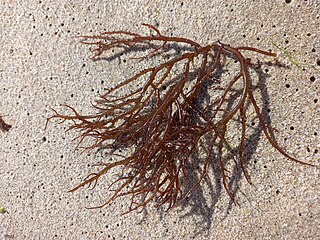
Gracilaria coronopifolia, also known as limu manauea in Hawaiian, or ogo in Japanese, is a species of edible red algae (Rhodophyta) endemic to Hawai'i.

Dictyosphaeria versluysii is a species of green algae in the family Siphonocladaceae. This species is indigenous to Indonesia, with a world distribution ranging from the Pacific regions and extending to the Indian Ocean. It can be found in various countries including Mexico, China, Thailand, Vietnam, the Philippines, Australia, and Hawaii.
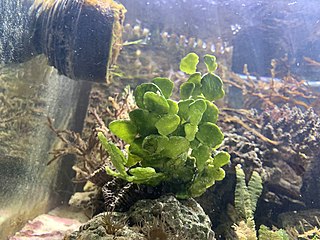
Halimeda discoidea is a species of calcareous green algae in the order Bryopsidales. It is commonly known as Money Plant due to its appearance and is usually found in the tropics.
















